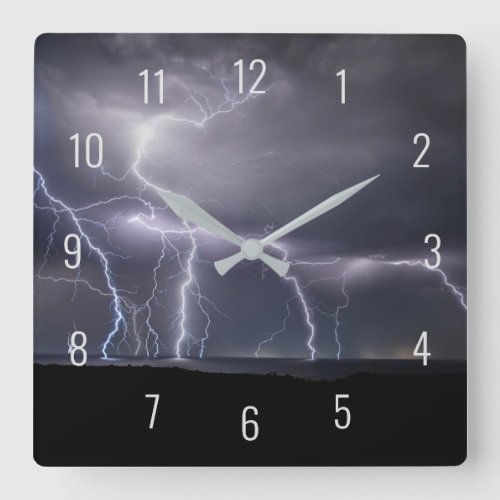Thunderstorm Lightning Storm Black & Purple Square Wall Clock



This stunning clock features a photo of an impressive lightning storm over the ocean at night. Multiple lightning strikes illuminate the dark sky and the ocean. What a spectacular sight. Get this amazing image on your wall and never forget about the time! A thunderstorm, also known as an electrical storm or a lightning storm, is a storm characterized by the presence of lightning and its acoustic effect on the Earth's atmosphere, known as thunder. Relatively weak thunderstorms are sometimes called thundershowers. Thunderstorms occur in a type of cloud known as a cumulonimbus. They are usually accompanied by strong winds, and often produce heavy rain and sometimes snow, sleet, or hail, but some thunderstorms produce little precipitation or no precipitation at all. Strong or severe thunderstorms include some of the most dangerous weather phenomena, including large hail, strong winds, and tornadoes. Some of the most persistent severe thunderstorms, known as supercells, rotate as do cyclones. While most thunderstorms move with the mean wind flow through the layer of the troposphere that they occupy, vertical wind shear sometimes causes a deviation in their course at a right angle to the wind shear direction. Thunderstorms result from the rapid upward movement of warm, moist air, sometimes along a front. However, some kind of cloud forcing, whether it is a front, shortwave trough, or another system is needed in order for the air to rapidly accelerate upward. As the warm, moist air moves upward, it cools, condenses, and forms a cumulonimbus cloud that can reach heights of over 20 kilometres (12 mi). As the rising air reaches its dew point temperature, water vapor condenses into water droplets or ice, reducing pressure locally within the thunderstorm cell. Any precipitation falls the long distance through the clouds towards the Earth's surface. As the droplets fall, they collide with other droplets and become larger. The falling droplets create a downdraft as it pulls cold air with it, and this cold air spreads out at the Earth's surface, occasionally causing strong winds that are commonly associated with thunderstorms.


